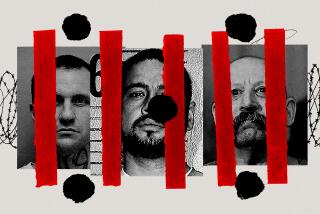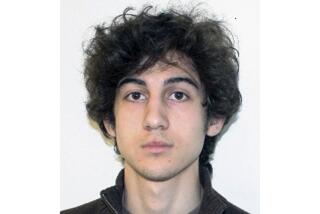Defense lawyers say Boston Marathon bomber was swayed by older brother
Reporting from Boston — Federal prosecutors Wednesday portrayed Dzhokhar Tsarnaev as an anti-American terrorist who had “murder in his heart” when he planted a pressure-cooker bomb near a group of children at the Boston Marathon finish line two years ago, and then coolly walked away.
But defense attorneys described the 21-year-old Russian immigrant as a pawn of his radicalized older brother, saying the younger sibling was less interested in jihad and more focused on “Facebook, cars, girls.”
As the long-delayed, long-awaited capital murder trial got underway at the federal courthouse here, opening statements made clear that the trial would not focus on whether Tsarnaev planted one of the two bombs used in the April 2013 terrorist attack, but why he did it and how severely he should be punished.
Even as defense attorney Judy Clarke acknowledged her client’s role in the attack and said he “must be held accountable for his actions,” she began laying a foundation to save him from a death sentence, saying Tsarnaev became “much more vulnerable” after his parents divorced and was influenced by his older brother, Tamerlan.
“He was drawn into his brother’s passion and plans,” she said. Holding up a picture of a smiling Dzhokhar as a young teenager, Clarke told the jury, “The question is why.”
Federal prosecutors contended that the Tsarnaev brothers were equally responsible for the bombings that killed three people and injured more than 260 others.
“The defendant committed all 30 crimes he is charged with,” government attorney William D. Weinreb said. Dzhokhar Tsarnaev collected radical militant material and on the day of the race “pretended to be a spectator although he had murder in his heart.”
Weinreb said Tsarnaev was motivated by a hatred of the U.S. and a devotion to Islam. “He believed he needed to punish America for killing Muslims overseas. And he did it because he thought it would help secure him a place in paradise.”
Weinreb told the jury that the younger Tsarnaev telephoned his brother seconds before the two blasts in an apparent attempt to work in sync to inflict the most damage possible. Tamerlan ignited his pressure-cooker bomb first. Dzhokhar laid his down in front of a store and near children who had climbed on a railing for a better view of the race.
“They were partners,” Weinreb said in his opening argument. “They agreed to do this together and they carried this out together.”
The blasts “shredded flesh, shattered bones, set people on fire and caused victims to die painful, bloody deaths,” Weinreb said.
Among the dead was 8-year-old Martin Richard, 4 feet, 5 inches tall and 70 pounds.
“The bomb damaged his entire body,” the prosecutor said. “It blew large holes in his chest and abdomen, exposing his ribs and organs and eviscerating his bowels. It blew his arm almost entirely off his body. He lost so much blood, he had virtually none left when he was brought to the morgue.”
Afterward, Weinreb said, Dzhokhar Tsarnaev calmly walked to a store and purchased some milk. He then returned to the store and exchanged it for a different container. “All while Martin bled to death,” he said.
During a manhunt several nights later, he described the brothers shooting Massachusetts Institute of Technology police Officer Sean Collier, who was hit with two shots to the head. Weinreb also described a carjacking, the shootout with police in the Boston suburb of Watertown, and how Tamerlan Tsarnaev was killed as police moved to capture him.
The surviving brother was arrested the next day hiding in a boat stored in a backyard.
With the older Tsarnaev dead, Weinreb said, “the focus is going to be on this defendant. This is his day in court.”
During a much briefer opening statement, Clarke said that Dzhokhar came from a broken home and looked to his older brother as a role model.
Clarke said Tamerlan was the one who went to Russia’s Chechen region, who disrupted a Boston mosque with complaints that members were not radical enough, and who purchased the ammunition, fireworks, BBs, pressure cookers, backpacks and rubber gloves for the attack. Tamerlan, she said, “was immersed in death and destruction.”
Moments after Collier was killed, she said, Tamerlan was heard bragging, “I just killed a police officer.” When the brothers were surrounded on a Watertown street, he jumped from his car, firing at police and tossing homemade bombs at them, she said.
“It was Tamerlan Tsarnaev who self-radicalized, and it was Dzhokhar who followed him,” Clarke said.
After the opening statements, the jury heard about the history of the marathon and was shown an overhead video of the bombings, with smoke billowing, people running and falling, and police rushing to help.
Shane O’Hara, manager of Marathon Sports, a store near the finish line, was fitting a customer with shoes when the blasts hit. In a store video he is seen applying a tourniquet to a woman bleeding from the knees.
“It was kind of controlled chaos,” O’Hara testified. “After that one moment everyone is on the ground. The only ones still standing are those who were not hurt.”
Prosecutors brought in a series of victims to testify, hoping to use their recollections to build a case against Tsarnaev.
Karen McWatters of Somerville, Mass., recalled being next to Krystle Campbell, who died of her injuries.
“We put our faces together,” said McWatters, who lost her leg. “We tried to talk. I didn’t truthfully realize how bad her injuries were. Very slowly she said her legs hurt. She put her hand in mine. Shortly after that her hand went limp.”
richard.serrano@latimes.com
Twitter: @RickSerranoLAT
More to Read
Sign up for Essential California
The most important California stories and recommendations in your inbox every morning.
You may occasionally receive promotional content from the Los Angeles Times.










